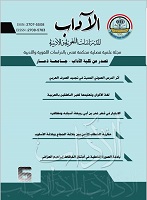The Child Image in the Novel The path’s children by Taher Al-Zahrani
DOI:
https://doi.org/10.53286/arts.v1i6.265Keywords:
Child, Al-Sabeel, Al-Haram Incident, The Wicked Crow, The Second Gulf WarAbstract
This paper aims to study the image of child and some childhood’s cases in the Saudi narrative text. The importance of this research lies in monitoring the extent of the success of the novelist, Taher Al-Zahrani, in expressing the image of the child and some childhood problems in his novel 'The path’s children, which confirms the importance of the novel's role in addressing the problems and aspirations of society. This research came in the introduction and preface and two sections and a conclusion in which the most important results are presented. In the introduction, the researcher mentioned briefly the importance of the research, its causes, goals, methodology, questions and plan, and the introduction came under the title 'The path’s children', in the course of caring for the novel with childhood. The first section addresses an image of the child's suffering in the novel 'The path’s children. The second topic discusses the child's image in the narrative speech of the novel. The conclusion came to summarize the most important results of the study.Among the most important results is that the novelist, Taher Al-Zahrani, was able to monitor many of the childhood problems, suffering and future negative effects in a period of time spanning from the Al-Haram incident to the second Gulf War in the Al-Sabeel area in Jeddah. The writer is highly skilled in employing many thresholds and narrative techniques in his novel 'The path’s children'.Downloads
Downloads
Published
How to Cite
Issue
Section
License
Copyright (c) 2021 عائشة يحيى عثمان حكمي

This work is licensed under a Creative Commons Attribution 4.0 International License.
Copyright and Licensing
copyright is retained by the authors. Articles are licensed under an open access Creative Commons CC BY 4.0 license, meaning that anyone may download and read the paper for free. In addition, the article may be reused and quoted provided that the original published version is cited. These conditions allow for maximum use and exposure of the work.



